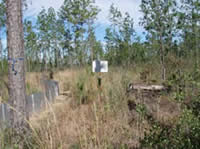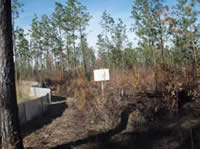
National Fire Plan Success Story
Hazardous Fuels Reduction and Mississippi Gopher Frog Habitat Management
De Soto Ranger District, National Forests in Mississippi
National Fire Plan - Restoration
2007
The Mississippi Gopher Frog is considered the most imperiled amphibian in the Southeast. This distinct population segment was listed as Endangered in 2002. The US Fish and Wildlife Service estimates there are about 100 adult Mississippi Gopher Frogs. There are only 3 ponds used for breeding, with the largest population at Glen's Pond, located on the De Soto Ranger District, National Forests in Mississippi. Major threats to the conservation of the Mississippi Gopher Frog include urban encroachment, low population numbers, limited additional potential breeding sites, and drought, which limit successful reproduction.
Heavy southern rough fuels characterize the southern part of the De Soto Ranger District, where Glen's Pond is located. In addition to these volatile live fuels, hurricane Katrina has added many tons per acre of dead fuel. The area surrounding Glen's Pond includes subdivisions, new developments, a high school, a PGA level golf course and major highways. The Wildland Urban Interface (WUI) situation here makes this part of the Forest a high priority for hazardous fuels treatments, as well as one of the most challenging sites for prescribed fire. Timing and attention to smoke management are critical.
Fortunately, the Gopher Frog's habitat requirements are compatible with hazardous fuels needs. In fact, biologists agree that frequent prescribed fire produces good habitat for the frog. However, prescribed fire treatments must be carefully timed based on Gopher Frog movements. All these factors make the effective use of prescribed fire, in this area, extremely difficult.
Recently, collaboration meetings have resulted in great strides towards a consensus on habitat management and timing of prescribed fire. The meetings included representatives from: U.S. Fish & Wildlife Service, U.S. Forest Service, University of Southern MS, Audubon Nature Institute, MS Museum of Natural Science, Memphis Zoo, Henry Doorly Zoo - Omaha, MS Department of Wildlife Fisheries and Parks, The Nature Conservancy and Western Carolina University.
A window of opportunity came less than one week after the meeting in early January. This was the first burn in the Glen's Pond area since hurricane Katrina. The communications between many different agencies is beginning to pay off in both habitat recovery and hazardous fuels treatments.

Before prescribed burn.

After prescribed burn.
Contacts
- Jay Boykin, De Soto Ranger District, Fire Management Officer, (601) 528-6163
- Diane Tyrone, De Soto Ranger District, Wildlife Biologist, (601) 528-6183